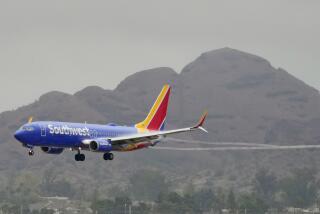Airlines’ plans to improve service are barely off the ground
NEXT month marks the eighth anniversary of a debacle that redefined air rage: In January 1999, thousands of fliers endured hours trapped in Northwest Airlines jets at the snowbound Detroit airport, waiting for gates to free up.
But here’s a date the airline industry can celebrate: June 17, 1999. That’s when it publicly swore to treat passengers better, thereby heading off regulation by an outraged Congress. And now it looks as though fliers were taken for a ride.
It’s hard to reach any other conclusion after reading a federal review, released two days before Thanksgiving, of 15 airlines’ compliance with promises in so-called customer-service commitments the industry made in 1999.
Now, as then, most carriers fail to consistently compensate bumped passengers or let frequent fliers know their true chances of landing award seats, and more than 40% of the time their gate agents don’t offer adequate updates on flight delays, according to the office of the inspector general of the U.S. Department of Transportation.
Only five of the airlines, the report said, properly monitored their own compliance with the service commitments, contrary to a promise made to Congress in June 2001 by the Air Transport Assn., a trade group that represents most big U.S. carriers. That count has declined from 2001, when 12 airlines were doing the audits, the report added.
In a two-paragraph news release, James May, ATA president and chief executive, reacted to the federal study this way:
“The DOT inspector general’s report found airlines’ customer service commitments are intact and incorporated in airlines’ contracts of carriage. While the report notes a few areas for improvement, the airlines have worked diligently to reduce the rate of annual complaints 70% since 2000.”
He’s right about service complaints filed with the DOT. Between 2000 and 2005, the rate dropped from nearly three passengers in every 100,000 to less than one per 100,000 for the biggest airlines, although not everyone credits the industry for this.
Growth in low-cost carriers such as Southwest and JetBlue, which generate fewer complaints than the industry average, and more self-service technology may be bigger factors in the decrease, said Terry Trippler, airline expert for the travel website www.myvacationpassport.com.
Did the ATA’s May read the same report I did? Because most of its 46 pages detail failure after failure.
ATA spokesman David Castelveter was more conciliatory, if not exactly contrite, when I phoned him.
“Is there room for improvement?” he said. “Absolutely. Is there a commitment to improve? Absolutely.”
He added: “I think the report shows progress. I know the airlines recognize that customer service is the core of their business.”
To be fair, as the report notes, much has happened since the airlines made their promises in 1999. The terrorist attacks of Sept. 11, the Iraq war, economic stagnation and high fuel prices put the industry into a tailspin for several years.
But lately air traffic has been up, along with fares and profits. Planes fly nearly full.
For its study, the Office of Inspector General interviewed officials at federal agencies, the ATA and airlines, and sent inspectors to 17 airports to observe airline practices. In most cases, following the office’s policy, it did not identify which airlines were in compliance and which were not.
Here are excerpts from the 1999 “Airline Customer Service Commitment” by ATA’s member carriers (“the promise”) followed by some of the study’s findings (“the reality”):
The promise: “Notify customers of known delays, cancellations and diversions.”
The reality: Of 120 observations made by inspectors during delays and cancellations, the study said, gate agents failed to make timely announcements 50 times and gave inadequate information 54 times. On the plus side, fliers today get better automated notice of delays through the Internet, phones and PDAs, thanks to airlines’ investments in technology, it said.
The promise: “Handle ‘bumped’ passengers with fairness and consistency.”
The reality: Nine airlines did not adhere to their own policies for compensating fliers who volunteered to give up their seats on oversold flights, and two did not properly disclose their boarding priority rules. In one example, four volunteers each received a $400 travel voucher, and five from the same flight each received a $200 voucher.
The promise: “Disclose ... rules, restrictions and an annual report on frequent-flier program redemptions.”
The reality: Four airlines didn’t publicly report how many fliers redeem award seats. The rest placed this information in financial reports, where it was “not easy to find,” or on the Internet in “locations ... not readily apparent,” the report said.
In any event, it added, it is “difficult, if not impossible, for consumers to compare frequent-flier programs in a meaningful way” because airlines report redemptions differently, such as by total only or as a percentage of passengers boarded.
Overall, the study found, fewer seats were available for frequent-flier awards in 2005 than in 2000, based on statistics from the six largest programs.
The promise: “Properly accommodate disabled and special-needs passengers.”
The reality: More than 80% of fliers with disabilities encountered problems, such as insensitive staff and delays in requested service at U.S. airlines and airports, according to a 2005 survey by the Harris Interactive polling company that the report cites.
Twelve of the 15 airlines and their contractors, the inspector general found, were not complying with their own policies or with federal requirements for training employees to interact with passengers with disabilities.
As we approach the end of 2006, it’s time for airlines to make a New Year’s resolution: Fulfill their service commitments.
*
More to Read
Inside the business of entertainment
The Wide Shot brings you news, analysis and insights on everything from streaming wars to production — and what it all means for the future.
You may occasionally receive promotional content from the Los Angeles Times.










